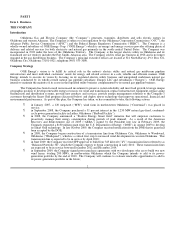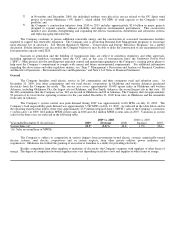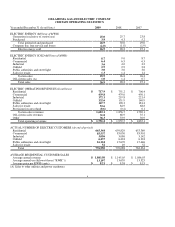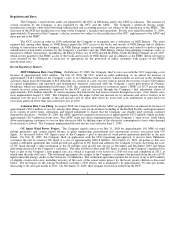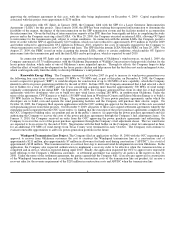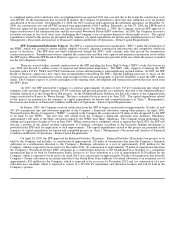OG&E 2009 Annual Report Download - page 16
Download and view the complete annual report
Please find page 16 of the 2009 OG&E annual report below. You can navigate through the pages in the report by either clicking on the pages listed below, or by using the keyword search tool below to find specific information within the annual report.
discovery of new facts or conditions will not cause it to incur significant costs. Approximately $1.9 million and $2.3 million,
respectively, of the Company’s capital expenditures budgeted for 2010 and 2011 are to comply with environmental laws and
regulations. It is estimated that the Company’s total expenditures for capital, operating, maintenance and other costs associated with
environmental quality will be approximately $20.9 million in 2010 as compared to approximately $19.9 million in 2009. Management
continues to evaluate its environmental management systems to ensure compliance with existing and proposed environmental
legislation and regulations and to better position itself in a competitive market. See “Item 7. Management’s Discussion and Analysis
of Financial Condition and Results of Operations – Environmental Laws and Regulations” and Note 12 of Notes to Financial
Statements for a discussion of environmental matters, including the impact of existing and proposed environmental legislation and
regulations.
Hazardous Waste
The Company’s operations generate hazardous wastes that are subject to the Federal Resource Conservation and Recovery
Act of 1976 (“RCRA”) as well as comparable state laws which impose detailed requirements for the handling, storage, treatment and
disposal of hazardous waste.
These laws impose strict “cradle to grave” requirements on generators regarding their treatment, storage and disposal of
hazardous waste. The Company routinely generates small quantities of hazardous waste throughout its system that include, but are not
limited to, waste paint, spent solvents, rechargeable batteries and mercury-containing lamps. These wastes are treated, stored and
disposed off-site at facilities that are permitted to manage them. Occasionally, larger quantities of hazardous wastes are generated as a
result of power generation-related activities and these larger quantities are managed either on-site or off-site. Nevertheless, through its
waste minimization efforts, the majority of the Company’s facilities remain conditionally exempt small quantity generators of
hazardous waste.
In December 2008, an impoundment used for the disposal of coal ash by a coal-fired power plant in Kingston, Tennessee
failed, releasing more than five million cubic yards of ash onto adjacent land and into a nearby river. Shortly thereafter, the EPA
announced its intention to avert similar incidents by promulgating rules to regulate coal ash by the end of 2009 pursuant to its
authority under the RCRA. However, in December 2009, the EPA announced that the deadline for promulgating those rules had been
extended indefinitely due to the complexity of the technical analyses involved in the rulemaking process. Thus, the extent to which the
EPA intends to regulate coal ash is uncertain at this time. At issue is whether the EPA intends to regulate coal ash as a hazardous
waste pursuant to Subtitle C of the RCRA and the impact such regulation will have on its future disposal and beneficial use insofar as
the Company is concerned. The Company’s coal-fired power plants do not dispose of coal ash on-site. Instead, the ash is
commercially disposed off-site or is marketed for a variety of beneficial uses including those related to the cement/concrete
manufacturing and road construction industries. Because of the uncertainty surrounding the EPA’s decision on how coal ash will be
regulated, the financial impact on the Company is uncertain at this time.
Site Remediation
The Comprehensive Environmental Response, Compensation and Liability Act of 1980 (“CERCLA”) (also known as
“Superfund”) and comparable state laws impose liability, without regard to fault or the legality of the original conduct, on certain
classes of persons responsible for the release of hazardous substances into the environment. Such classes of persons include the
current and past owners or operators of sites where a hazardous substance was released, and companies that disposed or arranged for
disposal of hazardous substances at offsite locations such as landfills. CERCLA authorizes the EPA and, in some cases, third parties to
take actions in response to threats to the public health or the environment and to seek to recover from the responsible classes of
persons the costs they incur. Because the Company utilizes various products and generate wastes that either are or otherwise contain
CERCLA hazardous substances, the Company could be subject to burdensome liability for the costs of cleaning up and restoring sites
where those substances have been released to the environment. At this time, it is not anticipated that any associated liability will cause
any significant impact to the Company.
Air Emissions
The Company’s operations are subject to the Federal Clean Air Act, as amended, and comparable state laws and regulations.
These laws and regulations regulate emissions of air pollutants from various industrial sources, including electric generating units, and
also impose various monitoring and reporting requirements. Such laws and regulations may require that the Company obtain pre-
approval for the construction or modification of certain projects or facilities expected to produce air emissions or result in the increase
of existing air emissions, obtain and strictly comply with air permits
12


